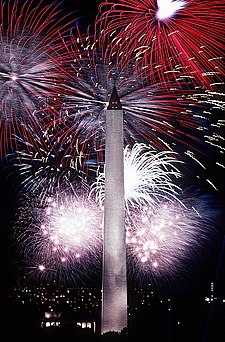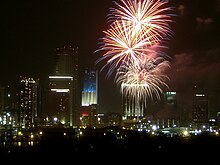Independence Day (United States)
| Independence Day | |
|---|---|
 Displays of fireworks, such as these over theWashington Monument, take place across the United States on Independence Day. | |
| Also called | The Fourth of July The Fourth |
| Observed by | United States |
| Type | National |
| Significance | The day the Declaration of Independence was adopted by the Continental Congress |
| Date | July 4 |
| Celebrations | Fireworks, Family reunions, Concerts, Barbecues, Picnics,Parades, Baseball games |
Independence Day, commonly known as the Fourth of July, is a federal holiday in theUnited States commemorating the adoption of the Declaration of Independence on July 4, 1776, declaring independence from the Kingdom of Great Britain. Independence Day is commonly associated with fireworks, parades, barbecues, carnivals, fairs, picnics, concerts,baseball games, family reunions, and political speeches and ceremonies, in addition to various other public and private events celebrating the history, government, and traditions of the United States. Independence Day is the national day of the United States.[1][2][3]
Contents[hide] |
Background
During the American Revolution, the legal separation of the Thirteen Colonies from Great Britain occurred on July 2, 1776, when the Second Continental Congress voted to approve a resolution of independence that had been proposed in June by Richard Henry Lee ofVirginia declaring the United States independent from Great Britain.[4][5] After voting for independence, Congress turned its attention to the Declaration of Independence, a statement explaining this decision, which had been prepared by a Committee of Five, withThomas Jefferson as its principal author. Congress debated and revised the Declaration, finally approving it on July 4. A day later, John Adams had written to his wife Abigail:
The second day of July, 1776, will be the most memorable epoch in the history of America. I am apt to believe that it will be celebrated by succeeding generations as the great anniversary festival. It ought to be commemorated as the day of deliverance, by solemn acts of devotion to God Almighty. It ought to be solemnized with pomp and parade, with shows, games, sports, guns, bells, bonfires, and illuminations, from one end of this continent to the other, from this time forward forever more.[6]
Adams's prediction was off by two days. From the outset, Americans celebrated independence on July 4, the date shown on the much-publicized Declaration of Independence, rather than on July 2, the date the resolution of independence was approved in a closed session of Congress.[7]
There is no question that July 4, 1776 is the date that the Congress approved the final official document, having voted to declare independence two days earlier.[8] Thomas Jefferson, John Adams, and Benjamin Franklin all later wrote that they had also signed it on that day. However, most historians have concluded that the Declaration was signed nearly a month after its adoption, on August 2, 1776, and not on July 4 as is commonly believed.[9][10][11][12][13]
In a remarkable coincidence, both John Adams and Thomas Jefferson, the only signers of the Declaration of Independence later to serve as Presidents of the United States, died on the same day: July 4, 1826, which was the 50th anniversary of the Declaration. Although not a signer of the Declaration of Independence, but another Founding Father who became a President, James Monroe, died on July 4, 1831, thus becoming the third president in a row who died on this memorable day. Calvin Coolidge, the 30th President, was born on July 4, 1872, and, so far, is the only President to have been born on Independence Day.
Observance
 An 1825 invitation to an Independence Day celebration
An 1825 invitation to an Independence Day celebration- In 1777, thirteen gunshots were fired in salute, once at morning and once again as evening fell, on July 4 in Bristol, Rhode Island. Philadelphia celebrated the first anniversary in a manner a modern American would find quite familiar: an official dinner for the Continental Congress, toasts, 13-gun salutes, speeches, prayers, music, parades, troop reviews, and fireworks. Ships were decked with red, white, and blue bunting.[14]
- In 1778, General George Washington marked July 4 with a double ration of rum for his soldiers and an artillery salute. Across the Atlantic Ocean, ambassadors John Adams andBenjamin Franklin held a dinner for their fellow Americans in Paris, France.[15]
- In 1779, July 4 fell on a Sunday. The holiday was celebrated on Monday, July 5.[15]
- In 1781 the Massachusetts General Court became the first state legislature to recognize July 4 as a state celebration.[15]
- In 1783, Moravians in Salem, North Carolina, held a celebration of July 4 with a challenging music program assembled by Johann Friedrich Peter. This work was titled "The Psalm of Joy".
- In 1791 the first recorded use of the name "Independence Day" occurred.
- In 1820 the first Fourth of July celebration was held in Eastport, Maine which remains the largest in the state.[16]
- In 1870, the U.S. Congress made Independence Day an unpaid holiday for federal employees.[17]
- In 1938, Congress changed Independence Day to a paid federal holiday.[18]
Customs


No comments:
Post a Comment